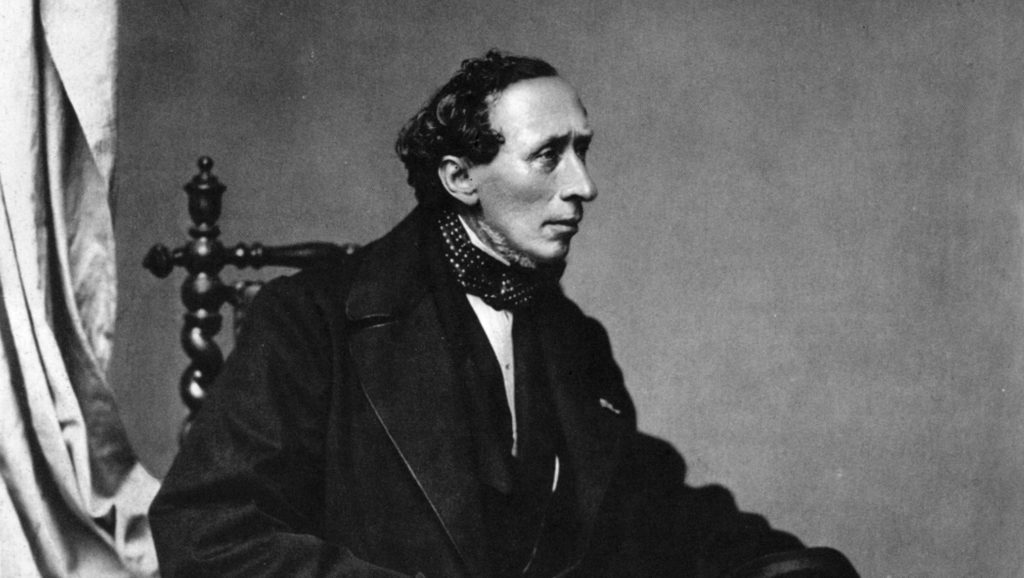Danish writer Hans Christian Andersen (1805-1875) is beloved the world over for such children’s classics as “The Ugly Duckling,” “The Little Mermaid,” and “The Emperor’s New Clothes.”
My penchant for melodrama started early, and Andersen’s stories pierced my young heart.
During New Hampshire winters, for example, I closely identified with the heroine of “A Little Match Girl,” tearfully imagining that one New Year’s Eve I, too, would expire of hunger and cold on a street corner, lips blue with cold, and be carried off to heaven.
As an adult, I learned that when Andersen died, a decades-old letter from Riborg Voigt, the first woman he ever loved (naturally, unrequitedly), was found in a little leather pouch around his neck. That was when I knew that Hans and I were truly soulmates.
So what formed his delicate constitution? Biographies abound. My favorite is Monica Stirling’s 1965 “The Wild Swan: The Life and Times of Hans Christian Andersen” (Collins, $40.27).
Stirling doesn’t analyze the stories much. Rather, she charts Andersen’s childhood, lifelong travails, the development of both his hypersensitive psyche and delightfully charming, if overwrought personality, love for travel, longing for home, and compulsive failure ever to settle in one place.
Wildly gifted, from the beginning Andersen was also neurotic of the first order. His childhood was marked by poverty and shame. Ungainly, awkward, and painfully shy, he nonetheless believed fiercely in his talents and from a very young age, boldly put himself before the public eye every chance he got.
His moods oscillated from high euphoria to bleakest despair, depending on the approval and love from those around him.
An incident from his student years sets the tone:
“He was plunged into misery until, after class, a fellow candidate, Miss Tønder-Lund, gave him a rose, whereupon he became as blissfully sure that he was surrounded by friends as he had a few minutes earlier felt himself a prey to enemies. The diary he kept intermittently for most of his life shows that what would be mere trifles to a person with an average nervous system — if such exists — were thunderbolts to him, with the result that he constantly oscillated between joy and anguish with almost no intermediate stages.”
Contemporary biographies predictably focus on Andersen’s supposed homosexuality. Stirling treats the issue with delicacy and restraint, only noting that he seems to have been constitutionally unsuited for lasting romantic love of any kind.
“The kind of help Andersen needed did not exist. … As a boy, Andersen was undermined by a well-justified sense of insecurity that produced concomitant feelings of inadequacy, unworthiness and guilt; as a man, his lack of family ties and his failure to experience requited love and thereby found a family of his own made him utterly dependent on his friends for emotional sustenance. He was therefore constantly aware of a need, terrifying in its urgency, to please in both his private and professional life. From this came his hunger for fame.”
At the same time, his idealization of women and “native fastidiousness” were such that when a woman was attracted to him, he recoiled. At one point, a young beauty declared her infatuation with him; he was so appalled that when he learned she was mentally unbalanced, he felt profound relief.
Still, Andersen had also inherited a certain robustness from his hardworking, commonsense mother, and he was additionally blessed with a finely honed, self-deprecating sense of humor. Those two traits enabled him to maintain enough emotional equilibrium to function, eventually to accept his celibacy, and focus his considerable energy on his work, friends, and the worldly acclaim he had sought since leaving home at 14.
Andersen spent most of his adult life in hotels, rented lodgings, or the palatial homes of loyal friends, many of whom set aside a special suite of rooms that could be readied at a moment’s notice, where he was welcome to stay as long as he liked.
The irony is that Andersen, with his vast love of children, never married. In some way, he seemed to have remained forever a child himself.
Every child instinctively responds to the life-giving sacrifice of the Little Mermaid, who willingly lays down her life for the human prince she loves (while the prince, oblivious, goes off and weds another).
Every child gets a huge kick out of exposing the imposter, as the little boy does in “The Emperor’s New Clothes.”
Every child knows he or she has something shining deep within, however invisible to the world, thus one of Andersen’s most beloved tales, “The Ugly Duckling.”
From “Bartlett’s Book of Anecdotes”: “Late in life Andersen’s health declined rapidly; first he developed chronic bronchitis, then the more serious, and ultimately fatal liver cancer. Unable to care for himself, he moved into the house of some friends near Copenhagen, where he could see the ocean from his room. One morning he quietly finished his tea, and was found a few minutes later in his bed, dead. In his hands was a farewell letter written forty-five years earlier by the only woman he had ever loved.”
Or as British writer Philip Pullman observes, “ ‘Thou shalt not’ is soon forgotten, but once upon a time lasts forever.”

